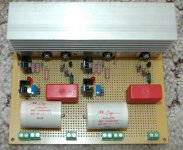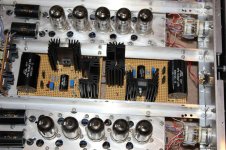Its the latter. A "snubber" or Zobel network more precisely. Voltage drop across that resistor will be insignificant because it just poses "ESR" there. That capacitor has all of it across in essence. The values are critical enough and better not be altered unless someone optimizes damping for a specific load evaluating with lab gear. In general its a little wonder how this design interfaces with so many people's stuff without a multitude of major drama stories. One thing is I don't push the spec too far on purpose, it could be impressive to have 1/3 the now Zo and 3x the now bandwidth, but it would not be generally easy to get widely applied with simple means and no deeper understanding effort. There is a point of diminishing returns subjectively also, so its a juggling act to make a useful general purpose solid state HV shunt reg with some field success. Until now it seems serving the goals rather satisfactorily is my impression. The main purpose is to bring good tonality regulation in compact space with better damping for little money and weight VS iron clad traditional passive filtering cells. A rail hum killer with added value and good sonics in other words.
Thanks - that makes sense.
Alex
This is my #26 preamp SSHV2 regulator... DN2540 CSS and the shunt mosfet on the same sink..
250V input, 220V/ 5.5+5.5 mA output (cCCS are 20mA).
Heat sink about 45 degree Celsius (after 4-5 hour).
Attachments
Yes........... is it S+/S0 that makes one twisted pair and F+/F0 that makes the other,..........
All flow and return pairs must be close coupled.
And that includes ON the regulator PCB and ON the Receiver PCB.
S for Sense and F for Force (Vout) I guess
Correct. Usually its only plus (signal, hot,) and minus (return, cold) that shall be twisted in general application, but I'm not sure what Salas recommended here.
Thanks Andrew. Needed some moral support
S0 & F0 soldered togheter at the load S+ & F+ soldered togheter at the load.
As promised, here is a photo of the two SSHV2 regulators installed in my RTP3.
There is a definite advance in stability and presence over the (probably malfunctioning) HPHV regs they replaced.
Alex
Hi Alex,
What is HPHV?
What capacitors did you use for the Salas Shunt?
Hi Alex,
What is HPHV?
What capacitors did you use for the Salas Shunt?
HPHV is Emile Sprenger's shunt reg. I would post a link to it, but Emile took his pages on it down two or three years ago. If anyone is interested I can send the user manual privately. I suspect that on a professionally made PCB this sophisticated and complex circuit should work very well, but I found mine were unstable and unreliable. This is why I hankered after a much simpler and more robust regulator circuit, and settled on the SSHV2.
The caps are SCR 630V polypropylenes (which I also used in the PSU).
Alex
Alex, very nice. Thanks for the update. You followed the parts layout of the printed board I saw. Is the pre-amp a Vacuum State original construction or just follows it?
Thanks!
Yes, the RTP3 is my own build, but (as with my version of your reg board) a close copy of the "real thing".
Alex
Has anyone noticed an audible difference using and not using sense/force connections?
Long distances without sense/force poor sound, short distances using or not using sense/force good sound.
Long distances defeat the main advantage of regulated supplies, namely low output impedance.
Long distances must have high impedance.
To get the benefit of regulated supplies the regulator should be right next to the client circuit.
The higher the current slew rates the worse this problem becomes.
At very high current slew rates, using regulators on long distance leadouts is a waste of resources.
Remote sensing does not solve long distance powering.
Long distances must have high impedance.
To get the benefit of regulated supplies the regulator should be right next to the client circuit.
The higher the current slew rates the worse this problem becomes.
At very high current slew rates, using regulators on long distance leadouts is a waste of resources.
Remote sensing does not solve long distance powering.
- Home
- Amplifiers
- Power Supplies
- Simplistic MosFET HV Shunt Regs

